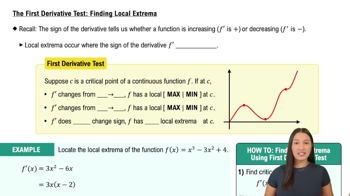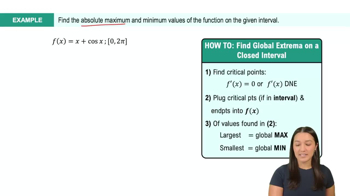Table of contents
- 0. Functions7h 52m
- Introduction to Functions16m
- Piecewise Functions10m
- Properties of Functions9m
- Common Functions1h 8m
- Transformations5m
- Combining Functions27m
- Exponent rules32m
- Exponential Functions28m
- Logarithmic Functions24m
- Properties of Logarithms34m
- Exponential & Logarithmic Equations35m
- Introduction to Trigonometric Functions38m
- Graphs of Trigonometric Functions44m
- Trigonometric Identities47m
- Inverse Trigonometric Functions48m
- 1. Limits and Continuity2h 2m
- 2. Intro to Derivatives1h 33m
- 3. Techniques of Differentiation3h 18m
- 4. Applications of Derivatives2h 38m
- 5. Graphical Applications of Derivatives6h 2m
- 6. Derivatives of Inverse, Exponential, & Logarithmic Functions2h 37m
- 7. Antiderivatives & Indefinite Integrals1h 26m
- 8. Definite Integrals4h 44m
- 9. Graphical Applications of Integrals2h 27m
- 10. Physics Applications of Integrals 2h 22m
5. Graphical Applications of Derivatives
Finding Global Extrema
Problem 4.1.59
Textbook Question
Absolute maxima and minima Determine the location and value of the absolute extreme values of ƒ on the given interval, if they exist.
ƒ(x) = (4x³/3) + 5x² - 6x on [0,5]
 Verified step by step guidance
Verified step by step guidance1
First, find the derivative of the function ƒ(x) = \( \frac{4x^3}{3} + 5x^2 - 6x \). This will help us identify critical points where the slope of the tangent is zero or undefined.
Set the derivative equal to zero to find the critical points. Solve the equation \( \frac{d}{dx} \left( \frac{4x^3}{3} + 5x^2 - 6x \right) = 0 \).
Evaluate the function ƒ(x) at the critical points found in the previous step, as well as at the endpoints of the interval [0, 5]. This will help determine the potential locations of absolute extrema.
Compare the values of ƒ(x) at the critical points and the endpoints. The largest value will be the absolute maximum, and the smallest value will be the absolute minimum on the interval.
Conclude by stating the location and value of the absolute maximum and minimum based on the evaluations from the previous step.
 Verified video answer for a similar problem:
Verified video answer for a similar problem:This video solution was recommended by our tutors as helpful for the problem above
Video duration:
5mPlay a video:
Was this helpful?
Key Concepts
Here are the essential concepts you must grasp in order to answer the question correctly.
Critical Points
Critical points are values of x in the domain of a function where the derivative is either zero or undefined. These points are essential for finding local maxima and minima, as they indicate where the function's slope changes. To locate absolute extrema on a closed interval, one must evaluate the function at these critical points as well as at the endpoints of the interval.
Recommended video:

Critical Points
First Derivative Test
The First Derivative Test is a method used to determine whether a critical point is a local maximum, local minimum, or neither. By analyzing the sign of the derivative before and after the critical point, one can infer the behavior of the function. If the derivative changes from positive to negative, the critical point is a local maximum; if it changes from negative to positive, it is a local minimum.
Recommended video:

The First Derivative Test: Finding Local Extrema
Endpoints of the Interval
When finding absolute extrema on a closed interval, it is crucial to evaluate the function at the endpoints of the interval in addition to the critical points. The absolute maximum or minimum could occur at these endpoints, especially if the function is not continuous or has no critical points within the interval. Thus, both critical points and endpoints must be considered to ensure all potential extrema are identified.
Recommended video:

Estimating the Area Under a Curve with Right Endpoints & Midpoint
Related Videos
Related Practice









